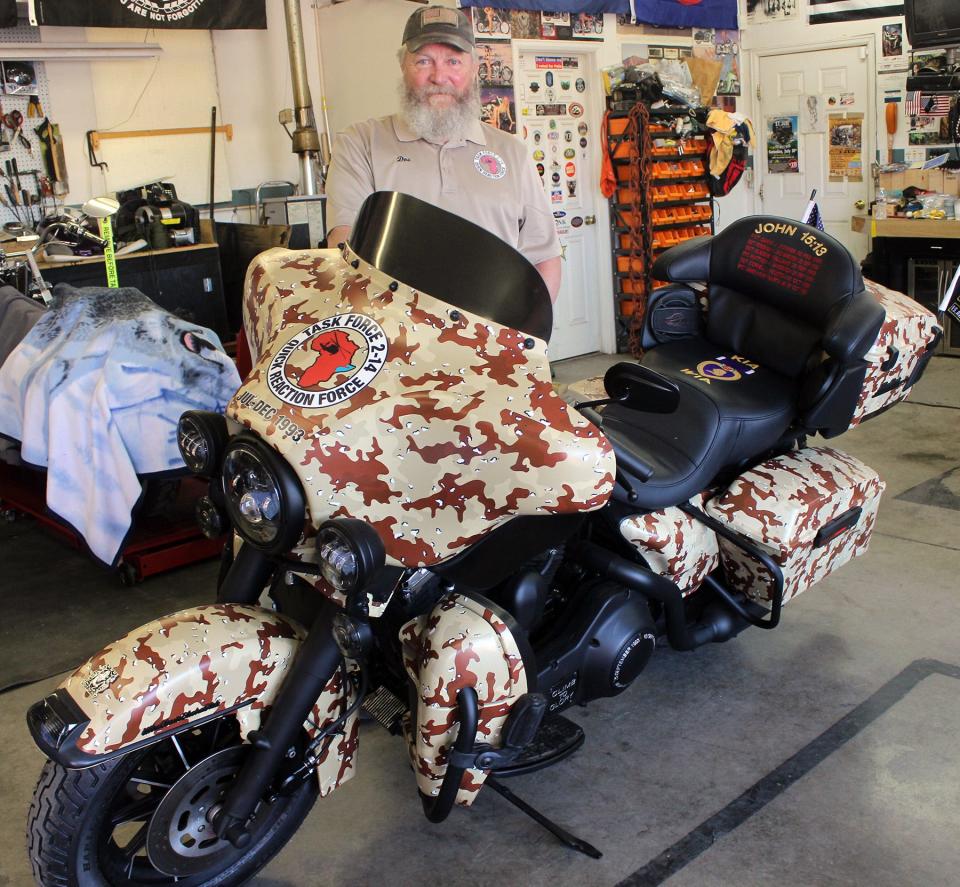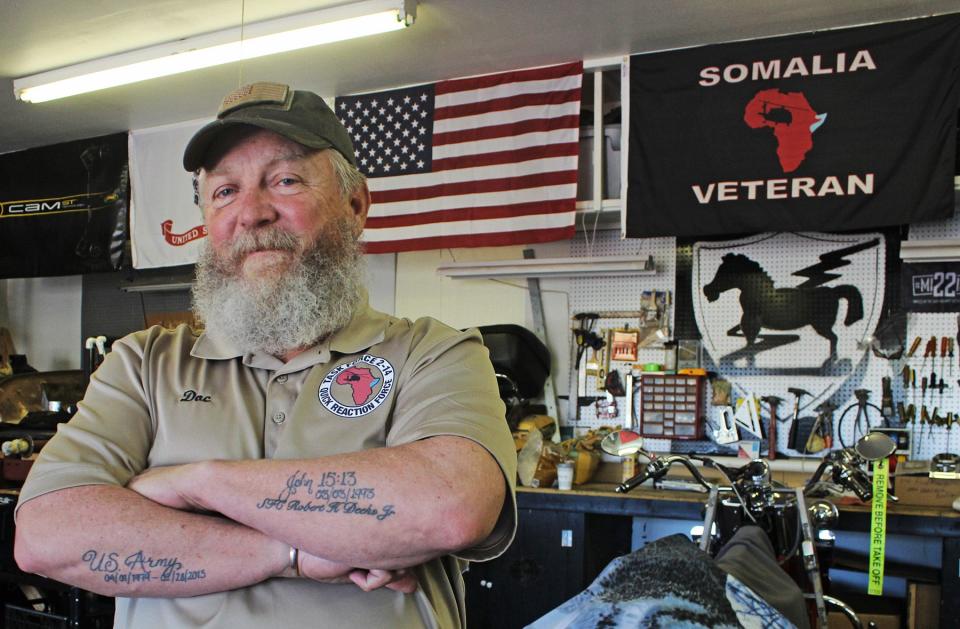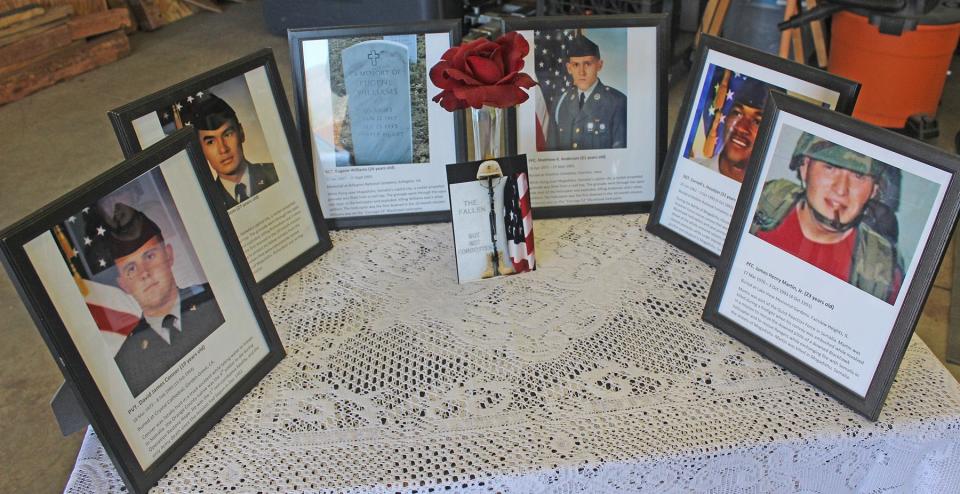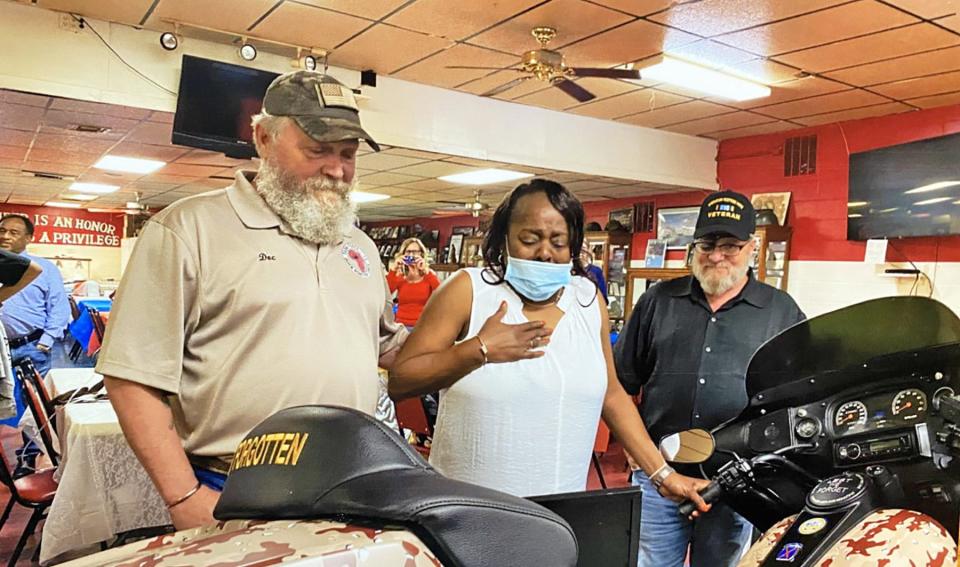Here's how a tribute to soldiers in the Battle of Mogadishu is helping a local veteran heal
A U.S. Army special forces medic who 30 years ago participated in the rescue of fellow soldiers during the Battle of Mogadishu is honoring the fallen with a tribute motorcycle he designed to help heal the scars of that hellacious battle.
Ed Ricord of Cañon City is a retired chief warrant officer who served 34 years in the U.S. Army, 28 of which were with the special forces. He created the tribute as a way to deal with his anger, work on healing and honoring “these guys who are absolutely forgotten,” he said.
Local residents will get a chance to see the fully restored 1993 Harley Davidson Electra Glide Ultra Classic on display in Pueblo starting May 20 and running through June 9 before it heads to Fort Drum, New York, for the 30th anniversary of the battle.
It is a tribute, in part, to the Battle of Mogadishu on Oct. 3-4, 1993, which was made famous by the “Black Hawk Down” book and movie. That battle started when two Black Hawk helicopters were shot down as Task Force Rangers worked to try to flush out a Somali warlord whose forces were seizing supplies the U.S. and other United Nations forces were providing as part of humanitarian food relief.

Ricord and members of the 2nd Battalion, 14th Infantry Regiment Quick Reaction Force, known as the 2-14, were tasked with helping starving Somalis by providing safe passage for those relief supplies and getting them medical equipment. Ricord was attached to a civil affairs battalion out of Fort Bragg, North Carolina, and served as a medic.
On March 3, his best friend was killed in action, so when he joined the task force in Somalia in July 1993, he said he felt he “had a reckoning to settle.”
The situation in the country was dire. Warlords with weapon caches made soldiers' task difficult — there were ambushes and rocket-propelled grenade launcher attacks. Before the October battle, a Black Hawk helicopter was shot down on Sept. 25 and Ricord and his team were sent in to secure what they could.
“When I went around the corner and saw it, it did not look like a Black Hawk helicopter. I secured one body and one bone. As we were loading them in a field ambulance, things went sideways and upside down and we started getting incoming rounds,” Ricord recalled.
He looked up and saw a soldier in need.
“I said, 'Cover me,' and I took off," Ricord said. "There was this guy down, a young guy, and as I got on top of him I said, ‘You picked one hell of a place to lay down' — it was in the middle of an intersection,” Ricord said.
Once that soldier was stabilized and transported by ambulance, Ricord put field dressings on a tank gunner who'd been shot in the leg. As the team was withdrawing, calls for a medic came in and Ricord found himself running down the street to put tourniquets on another soldier who lost his left arm and leg in an RPG attack.
By the time the dust had settled, the 2-14 had lost Sgt. Eugene Williams, Pfc. Matthew Anderson and Sgt. Ferdinan Richardson. Miraculously, the pilot and copilot of that helicopter survived.

Just eight days later, it was a late Sunday afternoon when the 2-14 got word that a U.S. Army Ranger Task Force “ran into more than what they anticipated,” Ricord said. As they were en route, they were told the first Black Hawk had been shot down.
“So there was anxiety because we knew a lot of those guys. By the time we got to the airfield the second had been shot down,” he said.
As Ricord’s team arrived it quickly became apparent that “hell was coming at us and we were the target,” Ricord said. They entered a traffic circle and were forced to jump out of their trucks to try to find cover.
“I saw a kid get hit. I took off, went straight to him, grabbed him, picked him up and extracted him to my truck,” Ricord recalled.
Once inside the truck, Ricord removed the soldier’s shirt to examine his wounded shoulder. He spotted a shoulder tattoo of the Tasmanian Devil.
“I told him, 'They missed Tasmania,' and he said, ‘Thanks, Doc,’” Ricord recalled with a laugh.
As they pushed farther into the conflict, Ricord said it "looked like the opening scene of Terminator."
"I saw hell,” he said.
That was when Sgt. Cornell Houston dismounted from the vehicle, worked to clear a road block and was wounded. Pfc. James Martin Jr. was rushing to Houston’s aid when he was killed.
Ricord was able to stabilize Houston, who was transferred to a hospital in Germany where he later died.
Once the two crash sites were secured, the team pulled back, set up a triage site and Ricord went to work. By the time he was done, his medic bag was empty and he was using pieces of uniforms to dress wounds.
He was finally ordered to get on a Huey helicopter and fly out with the last urgently-wounded soldier, a ranger who had been shot in the back. That ranger survived.
Back at the command center, Ricord collapsed on a gurney and did not wake up for 36 hours. Because he was motionless and covered in blood, “they thought I was dead,” he said.
More war news: 'This is their American Revolution': Beulah first responder recounts aid trip to Ukraine

When he finally woke up, there was an urgent request for him to call his mother. She had seen video of Somalis pulling a dead American soldier through the streets and was sure it was her son.
“I called home and said, ‘Mom, it’s me, Ed,” and she handed the phone to my little brother telling him, “That’s not Ed.’ My brother started talking to me and he looked at mom and said, ‘That’s Ed,’” he recalled.
Ricord was told the Battle of Mogadishu claimed 18 rangers in addition to Martin and Houston from the 2-14. Looking back, he's not sure how he survived. He figures he was helped by the fact he could run really fast.
Several books and movies recounted the horrific battle, but “Task Force 2-14 had been forgotten. In 2021 they upgraded 60 awards (battle medals) for the rangers, but there was no mention of 2-14,” he said.
“We didn’t even get a thank you. I got angry,” Ricord said.
His wife of 28 years, Laura, asked him what he was going to do about it. That was when he got the idea to create a tribute bike.
It took a year to find the 1993 Harley Davidson he needed. When he finally found it, he was in Grand Junction a couple days later loading it up. Back in Cañon City, he stripped it down to the frame and motor.
Ricord got a lot of help decking the bike out with new upholstery from Gary’s Upholstery that was embroidered with the names of all six fallen soldiers by Embroidery Plus, both of which are Pueblo businesses. In Cañon City, Quantum Wraps covered the bike with a camouflage wrap and Sentry Siren powder coated everything else.
Hand engraving by a Denver artist completed the detailing. Outpost Harley Davidson in Pueblo did all the maintenance and although the motorcycle runs perfectly, Ricord only rides it to load it on and off a trailer.
As the bike came together, day by day Ricord started to heal.
“I looked into the gates of hell. I am still working on healing,” he admitted.
“The goal is to have a living tribute and memorial to these guys, a place for family members to take their kids and grandkids to show them what they were a part of. It comes from the heart — it represents the emotional and physical cost to the guys of Task Force 2-14,” Ricord said.

Ed and Laura are working to find all of the six gold star families who lost loved ones in the 2-14 so they can sign the bike. They recently returned from Mobile, Alabama, where Sgt. Houston’s family was able to see it and sign it.
Any member of the task force is welcome to sign it. The bike will be in Pueblo from 11:45 a.m. to 1:45 p.m. on May 20 at the Praise Assembly of God Church, 2000 Troy Ave., where Ricord and fellow veterans will be stopping for lunch during the Run for the Wall, a motorcycle ride from California to Washington D.C.
After that, the bike will be on display at Outpost Harley Davidson, 5001 N. Elizabeth St., until June 9.
Ricord will then transport it to Fort Drum in New York for the 30-year reunion of the battle. He hopes it will stay there on display in the post museum.
“This is a (reason for) reuniting the task force to let the guys talk and work it out. Thirty years ago we were tight and we need to get back to that,” he said.
More information about the efforts of 2-14 in the battle can be found in the documentary "Black Hawk Down: The Untold Story."
Chieftain reporter Tracy Harmon covers business news. She can be reached by email at tharmon@chieftain.com or via Twitter at twitter.com/tracywumps.
More killed in action news: 'Life of the party': Former CSU Pueblo students and staff fondly remember Kyle McKenna
This article originally appeared on The Pueblo Chieftain: Tribute motorcycle to fallen Mogadishu soldiers set for Pueblo debut

